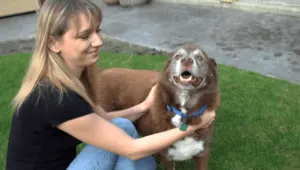
As our regular readers know, both Irie and Tiki were trained using positive reinforcement techniques, something we credit both for moving along their training faster and for creating a deeper bond between us. Today we have a special guest post from Aly DelaCoeur of the dog training video site WhyDoesMyDog.com about positive reinforcement training.
Positive reinforcement is one of the best ways to get your dog to do what you want it to do and is the method I use most. Here is some information that will help you learn better how to use this method.
Positive reinforcement happens when you present a desirable reinforcer as a consequence to a behavior. This causes the behavior to increase. The rule of thumb is if you are providing reinforcement, even if it is not conscious, your dog will repeat the behavior.
Reinforcement can be anything, attention, treats or toys. It is whatever motivates your dog. My number one concern with positive reinforcement is that many people become over dependent on treats and their dog won’t listen to them once the owner does not have treats. You need to start removing the lure from training as soon as possible (I suggest after 6-12 trials). Start at the basic steps for each command with treats and after a few, remove the lure.
Still reward. Your dog should not worry about you withholding anything when they do not preform how you want them. Praise, treats and rewards should be given freely rather than as the result of her compliance with your directives. It is important to support your dog. Use life rewards like going on walks, or getting pets, or jumping on the sofa or getting dinner instead of treats.
 You need to stop rewarding sub-par behavior once your dog is more advanced in his training. After he learns the command, give different rewards to reflect the quality of his performance. If you asked multiple times for your dog to sit, perhaps just a “good dog” will do and then repeat the exercise. If he does it on the first time, then it is a “good boy” plus a treat and pets! Be aware, some dogs are a little more insecure or unsure of themselves and may need motivational praise even when it takes them a little longer to do something.
You need to stop rewarding sub-par behavior once your dog is more advanced in his training. After he learns the command, give different rewards to reflect the quality of his performance. If you asked multiple times for your dog to sit, perhaps just a “good dog” will do and then repeat the exercise. If he does it on the first time, then it is a “good boy” plus a treat and pets! Be aware, some dogs are a little more insecure or unsure of themselves and may need motivational praise even when it takes them a little longer to do something.
Positive reinforcement can take longer than some other techniques, but you will get a more balanced and happier dog. Plus, your relationship will grow out of respect and love rather than fear and compliance.
About Aly DelaCoeur and www.WhyDoesMyDog.com
Aly DelaCoeur combines her love of dogs, years of experience, and the most up-to-date animal behavior science in WhyDoesMyDog.com. Her goal is to help you and your dog have a fuller, happier, and more rewarding relationship. Our unique platform optimizes content for consumption and sharing. Content is presented in mobile-optimized, short, to-the-point pieces designed to give just the information the user is looking for whenever they need it. All WhyDoesMyDog.com content is Creative Commons licensed to encourage sharing and reuse.
- Selecting the Best Online Emotional Support Animal Letter Service - December 14, 2023
- How to Store Dog Toys –10 Solutions to Organize Those Toys! - July 7, 2022
- Best Practices to Puppy-Proof Your Home - June 27, 2022
